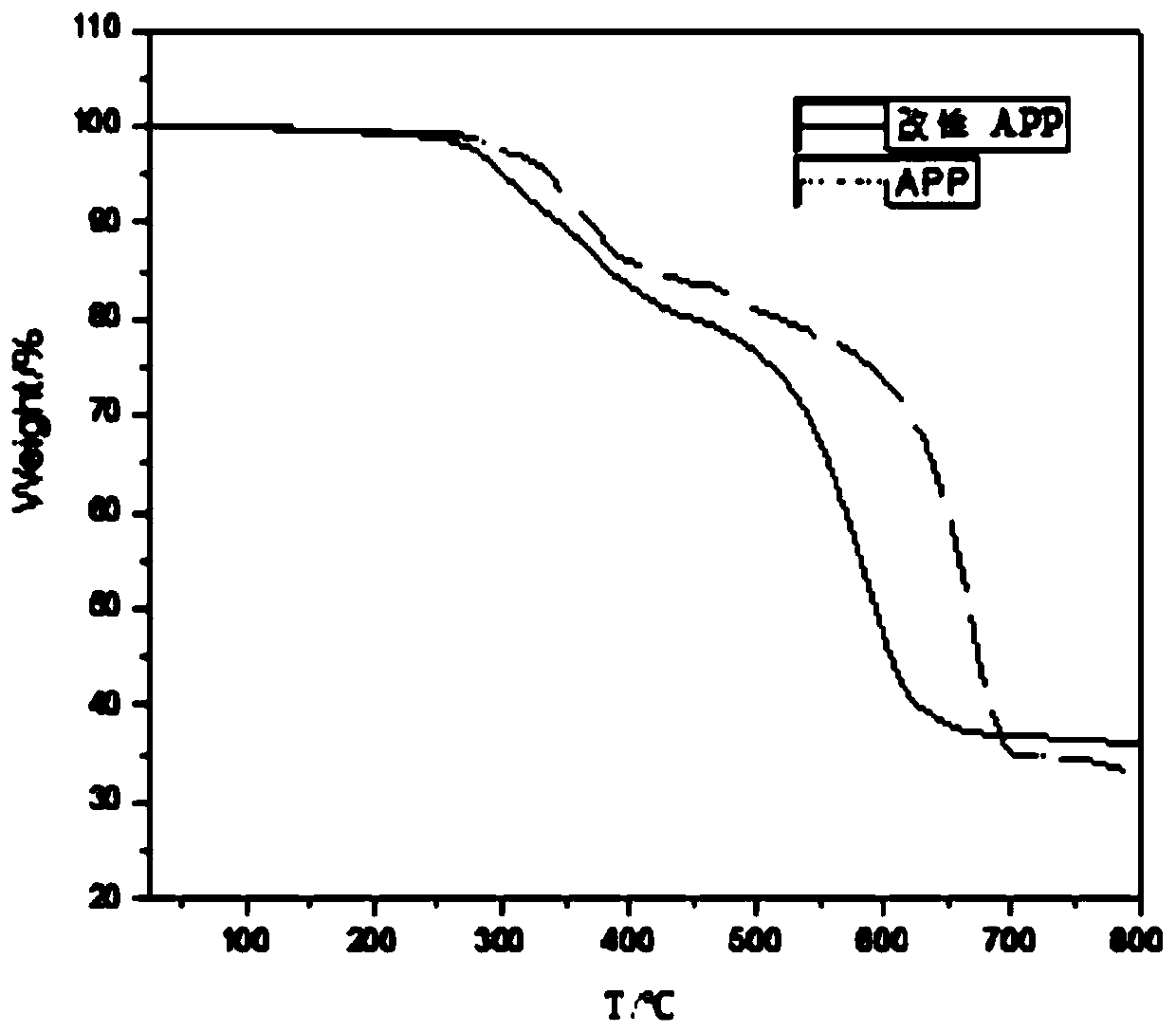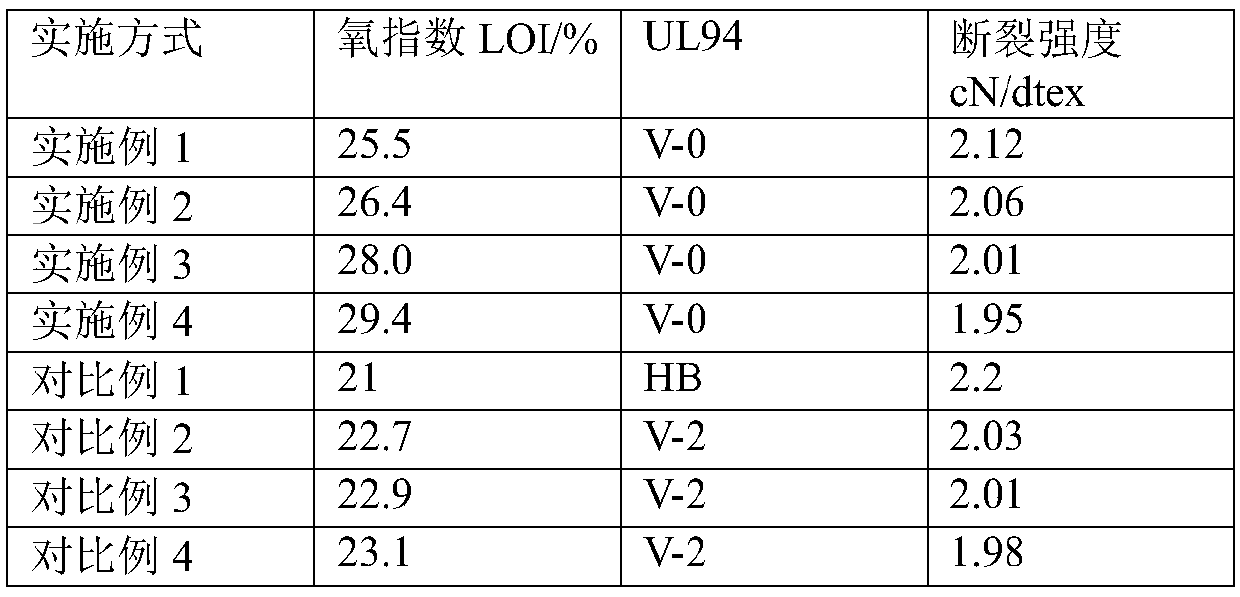Preparation method of modified ammonium polyphosphate-black phosphorus flame-retardant PET polyester
A technology of ammonium polyphosphate and black phosphorus, which is applied in the field of flame retardant engineering plastics, can solve the problems of unstable surface state and poor stability of nano black phosphorus, and achieve the effects of high stability, high thermal stability and reducing the amount of addition.
- Summary
- Abstract
- Description
- Claims
- Application Information
AI Technical Summary
Problems solved by technology
Method used
Image
Examples
preparation example Construction
[0034] A preparation method of modified ammonium polyphosphate-black phosphorus flame-retardant PET polyester, comprising the following steps:
[0035] 1) Preparation of composite flame retardant: Add the ground 1-2μm black phosphorus to the DMF solution at a solid-to-liquid ratio of 1.5-2.5g / L, and ultrasonically treat it at 0°C-5°C for 2-6h to obtain black phosphorus nanoparticles Dispersion of flakes, suction filtration and drying to obtain black phosphorus nano flakes; dissolve phenolic resin and black phosphorus in absolute ethanol, ultrasonic 10-30mi; then add ammonium polyphosphate and dimethyl silicone oil, stir at room temperature for 1-3h, Filter the obtained mixture, wash with ethanol, and dry in vacuum for 8h-12h to obtain modified ammonium polyphosphate-black phosphorus nanosheet powder, that is, a composite flame retardant. The mass ratio of the phenolic resin, black phosphorus, absolute ethanol, ammonium polyphosphate and dimethyl silicone oil is 2-5:0.3-0.6:50-...
Embodiment 1
[0044] 1) Grinding 1.0 g of massive black phosphorus to 1-2 μm, adding it to 500 mL of DMF solution, and ultrasonically treating it at 0° C. for 4 hours to obtain a dispersion of black phosphorus nanosheets, and drying by suction to obtain black phosphorus nanosheets;
[0045] 2) Dissolve 3 g of phenolic resin and 0.5 g of black phosphorus nanosheets in 60 g of absolute ethanol, and sonicate for 20 min. Then 5 g of ammonium polyphosphate and 0.2 g of simethicone were added, stirred at room temperature for 2 h, the mixture was filtered, washed with ethanol, and dried in vacuum for 12 h to obtain modified ammonium polyphosphate-black phosphorus nanosheet powder.
[0046] 3) Put 80% of the total amount of ethylene glycol and all the terephthalic acid into the beating tank to make a mixed slurry, and the molar ratio of the total amount of ethylene glycol to terephthalic acid is 1.5:1;
[0047] 4) Put 15% ethylene glycol and a catalyst into a catalyst preparation kettle, stir evenly ...
Embodiment 2
[0054] 1) Grinding 1.0 g of massive black phosphorus to 1-2 μm, adding it to 500 mL of DMF solution, and ultrasonically treating it at 0° C. for 4 hours to obtain a dispersion of black phosphorus nanosheets, and drying by suction to obtain black phosphorus nanosheets;
[0055] 2) Dissolve 3 g of phenolic resin and 0.5 g of black phosphorus nanosheets in 60 g of absolute ethanol, and sonicate for 20 min. Then 5 g of ammonium polyphosphate and 0.2 g of simethicone were added, stirred at room temperature for 2 h, the mixture was filtered, washed with ethanol, and dried in vacuum for 12 h to obtain modified ammonium polyphosphate-black phosphorus nanosheet powder.
[0056] 3) Put 80% of the total amount of ethylene glycol and all the terephthalic acid into the beating tank to make a mixed slurry, and the molar ratio of the total amount of ethylene glycol to terephthalic acid is 1.5:1;
[0057] 4) Put 15% ethylene glycol and a catalyst into a catalyst preparation kettle, stir evenl...
PUM
 Login to View More
Login to View More Abstract
Description
Claims
Application Information
 Login to View More
Login to View More - R&D
- Intellectual Property
- Life Sciences
- Materials
- Tech Scout
- Unparalleled Data Quality
- Higher Quality Content
- 60% Fewer Hallucinations
Browse by: Latest US Patents, China's latest patents, Technical Efficacy Thesaurus, Application Domain, Technology Topic, Popular Technical Reports.
© 2025 PatSnap. All rights reserved.Legal|Privacy policy|Modern Slavery Act Transparency Statement|Sitemap|About US| Contact US: help@patsnap.com


